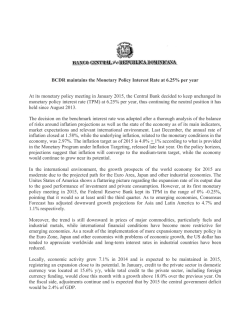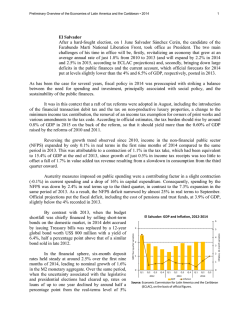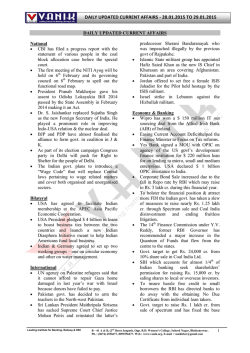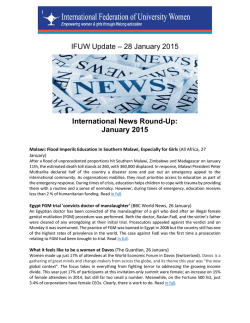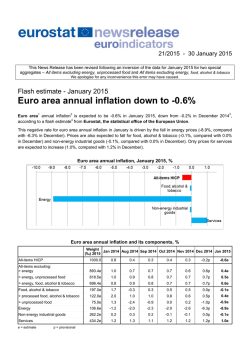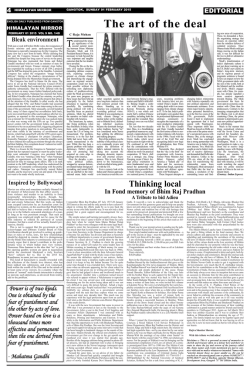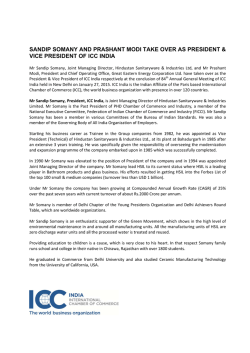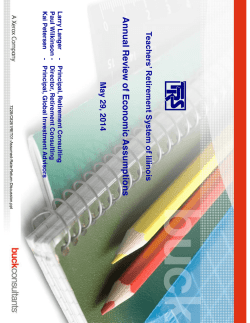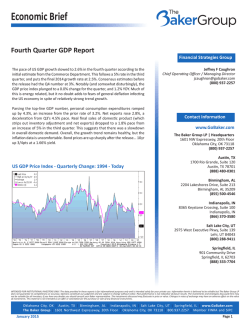
India and Mr. Modi: - JP Morgan Asset Management
India and Mr. Modi: After the Honeymoon Geoff Lewis, Ian Hui and Tai Hui January 2015 India and Mr. Modi: After the Honeymoon SYNOPSIS Key observations Key implications What has India's new leadership done since coming to power? As long as the Indian economy remains on a cyclical recovery track and Mr. Modi persists with his reform agenda, we believe the start of U.S. interest rate normalization by the Fed in 2015 poses a limited threat to India’s capital account. While a gradually rising U.S. dollar may be a headwind in 2015, it is unlikely to prompt large FII outflows in India’s case, a country blessed with good fundamentals and a strong secular domestic growth story. The medium-term outlook remains highly positive. • Mr. Modi seems to be taking a long-term view towards India’s structural problems. • So far, the majority of policy measures tabled are neither surprising nor breathtaking. They are being implemented across a broad front. Big reforms are expected to be relatively few. • A selection of reforms include greater co-operation between state and central governments, revamping the tax system, improving administration allowing greater accessibility and ease of doing business, labor market reforms and furthering financial inclusion. How has India and its economy responded? • Raising economic growth from multi-year lows, taming inflation and getting previously spiraling external and fiscal deficits under control are four key macro economic goals. There has been reasonably good progress in 2H 2014 on all four fronts. • India’s growth prospects already appear to be changing for the better, with forecasts for an uptick in consensus GDP growth in 2015 to 6% plus. • Inflation has seen a conflux of fortunate factors to bring it under control. • The fiscal deficit issue is now seen as much more contained. What issues do they still need to be aware of and keep in mind to tackle? • From here on, much will depend on the pace at which Mr. Modi can implement his reform agenda and how his policies begin to have an impact over the medium-term. • Sustaining CPI inflation below 6% through 2015 as economic growth accelerates with the business cycle and a relatively small output gap begins to close could still prove challenging. • Fiscal healing is still a very gradual process. Central government fiscal targets are still likely to overshoot. • The possibility of headwinds from a rising U.S. dollar and the normalization of Fed policy. 2 | India and Mr. Modi: After the Honeymoon Risk • Weaker-than-expected recovery in private sector capex and thus productivity • A surprise rebound in world oil prices and the return of inflation • Corporate earnings that remain slow to recover from the cyclical pressures of 2012-2014. What to watch for • For equity investors, the key near-term issue will be how long it takes before corporate profits and margins start to respond to the improving economy. • Investors in Indian equities should stay focused on domestic cyclicals, such as cement, materials, metals and autos, infrastructure plays and private sector financials, instead of exporters and defensive sectors like utilities. In 2015 we expect new support for domestic cyclicals and capex stocks from declining short-term interest rates. Geoff Lewis Executive Director Global Market Strategist Geoff Lewis, executive director, is a Global Market Strategist based in Hong Kong. With over 25 years of experience, Geoff is a frequent guest on Bloomberg, Reuters and CNBC, and is often quoted in the financial press. He provides timely insights on the Asian economies and markets to clients and media across Asia, and is a key speaker at investment conferences and seminars. He joined the firm in 1999 as Head of Investment Services. Prior to joining the firm, Geoff served as Asian Regional Economist with Dresdner Kleinwort Benson. Geoff began his career in 1970 as an Economic Adviser with the UK Treasury and was seconded to the Japanese Government’s Economic Planning Agency in Tokyo. Geoff obtained a B.Sc and an M.Sc. in Economics from the London School of Economics. Ian Hui, associate, is a Global Market Strategist. Based in Hong Kong and an employee since 2012, he is responsible for delivering market analysis and insights as well as regular publications and fundamental research on the global economy and capital markets. Prior to joining J.P. Morgan, Ian was at AXA Investment Managers as an Investment Analyst in the Tactical Asset Allocation Team, assisting with economic research and asset allocation decisions. Ian obtained a Bachelor’s degree in Commerce majoring in Econometrics and Finance from the University of Melbourne, Australia. Ian Hui Associate Global Market Strategist Tai Hui Managing Director Chief Market Strategist Asia Tai Hui, managing director, is the Chief Market Strategist Asia, based in Hong Kong. With over 10 years of experience, Tai is a frequent guest on Bloomberg, Reuters and CNBC and is often quoted in the financial press. He formulates and disseminates J.P. Morgan Funds’ view on the markets, economy and investing to financial advisors and their clients in the Asia region. Prior to joining J.P. Morgan, Tai served as the Regional Head of Research (Asia) with Standard Chartered Bank in Singapore, covering the economic and financial development of the Asia region and delivering his analysis to corporate and institutional clients. Tai obtained a Master of International and Public Affairs from the University of Hong Kong and a BA in Economics from Cambridge University. J.P. Morgan Asset Management | 3 India and Mr. Modi: After the Honeymoon TABLE OF CONTENTS India and Mr. Modi: After the Honeymoon In brief 5 Progress check 5 Policy and reform measures in abundance 6 Making India's current systems work better 8 How is India's economy responding to “Modinomics”? 8 Kick-starting India's capex cycle 9 Fiscal healing – A very gradual process 10 Good fortune on inflation 10 Wage pressures subsiding 11 More interest rate cuts are looming 12 India and foreign inflows – Threat or opportunity? 12 Portfolio flows a combination of “push” and “pull” factors 13 How would FII flows to India fare if the USD strengthens further? 14 Investment implications 14 4 | India and Mr. Modi: After the Honeymoon IN BRIEF In this paper we look at how Narendra Modi has fared as the new leader of India since storming to power in May 2014. We also review various reform measures and policies he has rolled out to improve India’s performance, as well as judge their impact on the economy thus far. Mr. Modi has had some fortuitous luck in bringing inflation under control and his policies have been generally well received, with the economy in the early stages of a cyclical recovery. Much now will depend on the pace at which he can implement his reform agenda and on the cumulative impact of his policies over the medium term. For equity investors, the key near-term issue will be how long it takes before corporate profits and margins start to respond to the improving economy. Progress check Since becoming Prime Minister of India in May 2014, with a landslide victory and lower house majority in parliament not seen in 30 years, Narendra Modi has been seen as a beacon of hope for India’s prospects, both economic and otherwise. In this paper, we take a look at India’s progress after being under the new leadership for over six months. CHART 2: IN 2015, INDIA WILL TOP THE NOMINAL GDP RANKINGS FOR THE INVESTABLE EMERGING MARKET UNIVERSE % nominal GDP growth Switzerland Russia Japan Australia Saudi Arabia Canada United States Everywhere we look, the signs are encouraging, with India punching above its weight by contributing more than 12% to world GDP growth this year (IMF WEO forecast), having become the world’s fourth largest economy in 2011, behind only the U.S., Eurozone and China when measured in PPP dollars. As seen in Chart 1, India in terms of current U.S. dollar GDP may soon surpass both Brazil and recession-hit Russia, to emerge as the second largest BRIC economy after China. CHART 1: INDIA – A MAJOR EMERGING MARKET ECONOMY THAT IS GAINING IN IMPORTANCE India’s Nominal GDP and forecasts compared to selected countries, USD trillion 4 Forecast France 3 Brazil Russia 2 Italy Canada 1 India’s GDP level 0 2012 2013 2014E 2015E 2016E 2017E 2018E 2019E Source: IMF WEO October 2014 database, J.P. Morgan Asset Management. January 2015. Brazil Mexico Turkey Indonesia Korea China India 0% 2% 4% 6% 8% 10% Source: IMF WEO October 2014 database, J.P. Morgan Asset Management. January 2015. So far, India’s stock market has held up well amid growing investor worries concerning the outlook for emerging market equities in 2015, which face rising U.S. interest rates, further economic slowdown in China and a sharp fall in commodity prices. Local Indian markets - both bonds and equities - were among the strongest performers last year, with the BSE 100 gaining 32%, behind only China A-shares with 53%, as shown in Chart 3. Post-election, Mr. Modi has thus far has not disappointed markets with his chosen path, though at some point a more meaningful Sensex correction than December's 4% dip seems likely, as technical indicators for Indian equities remain in overbought territory. If that happens, we advise investors to increase their equity exposure to India, as the market, in our view, has the best long-term growth fundamentals of any major emerging market economy. What could trigger a market correction? Catalysts that might test the patience of investors include a weaker-thanexpected recovery in private sector capex and thus productivity, a surprise rebound in world oil prices or corporate earnings that remain slow to recover from the cyclical pressures of 2012-2014. J.P. Morgan Asset Management | 5 India and Mr. Modi: After the Honeymoon CHART 3: INDIA WAS ONE OF THE TOP PERFORMING MARKETS IN 2014 Policy and reform measures in abundance Local index performance in 2014, returns in local currency A strategy of taking many small steps in the right direction makes a lot of sense for India. They can accumulate over time and eventually have a significant impact on underlying productivity trends and macroeconomic performance. Therein lies the real strength of “Modinomics,” which is helping to turn India into one of the more attractive longterm prospects among global emerging markets. Shanghai SE A Share Index India S&P BSE 100 Philippines PSE PSEi Indonesia SE Composite Index Thailand SET MSCI USA TOPIX 1st Section It is still early, but for his first semester our view would be to award Mr. Modi an “A-” for overall performance. “Minus” because a few things could have been done better, such as a more cooperative stance from India in trade negotiations. Broadly speaking though, Mr. Modi has met or exceeded initial expectations in most of the key areas where we had looked for change from the new government. Taiwan TAIEX FTSE Straits Times Index Hang Seng Index ASX All Ordinaries KOSPI Composite Index FTSE Bursa Malaysia KLCI -20% 0% 20% 40% 60% Source: FactSet. J.P. Morgan Asset Management. December 2014. One of the initial objectives for Mr. Modi and the NDA coalition government was to stabilize the Indian economy before tackling the many longer-term issues and challenges that the country faces. Raising economic growth from multiyear lows, taming inflation and getting previously spiralling external and fiscal deficits under control are four key macro economic goals. There has been reasonably good progress in 2H 2014 on all four fronts. At the same time, the new government has sought to prioritise reforms and policy adjustments necessary for the longer haul, recognising that it cannot tackle every issue at once. Mr. Modi seems to be taking a long-term view towards India’s structural problems. He knows that he has a full fiveyear term in which to push forward with his agenda, and more than likely two terms. After the passage of more than six months, we have a clearer idea today of what the Modi reform agenda entails. So far, the majority of policy measures tabled are neither surprising nor breathtaking. But unlike his critics, we see this as a major strength of the government’s approach, not a weakness. Most measures appear achievable given sufficient energy on the part of the central government and a good working relationship with key state administrations. They are being implemented across a broad front; if we were simply to list them all, the resulting table would run into several pages. 6 | India and Mr. Modi: After the Honeymoon Initially, the government suffered few disappointments, with the timely passage of legislation through parliament and a greater degree of cooperation from state governments than some had thought possible. More recently, the opposition has been less willing to cooperate, causing delays to some measures and forcing Mr. Modi to proceed by administrative ordinance, which only provides a stop-gap solution. The issue over which the Congress Party dug its heels in has little to do with economics (the voluntary conversion of a small number of non-Hindu Indians to the Hindu religion organised by a small right-wing nationalist party). But it may unfortunately be a sign that in India, as in the U.S., political cooperation from the opposition is a relatively scarce commodity. Recent reforms passed by ordinance in the winter parliament include re-allocation of coal mines to private sector interests, raising the insurance sector FDI ceiling, accelerating land acquisitions for Public Private Partnership (PPP) projects by reducing owners’ consent from 70% to 50%, and amendments to India’s Companies Act. These measures will go to the vote in the upcoming session of parliament, which opens in February. The government has also set an ambitious deadline of April 2016 for implementing the Goods and Services Tax (GST), the key tax reform for this parliament that was inherited from the previous Congress administration. The GST will require a constitutional amendment to get passed, not to mention much hard bargaining on revenue sharing between the states and central government. Moreover, the initial bill deals only with the changes in broad taxing powers (states give up entry tax but get to levy services tax). Many of the practical issues will be dealt with subsequently by the GST Council on a 75% majority vote. This will require at least 20 of India’s 31 states to vote in favour, and with the BJP currently only controlling 11, there is plenty of scope for slippage and delay, although the final outcome is not in question. Most of the reform schemes announced so far look set to put India on the right track for an improvement in long-term growth or potential output. Big reforms are expected to be relatively few, as Mr. Modi currently only has a minority in the upper house of parliament. However, BJP wins in two key state elections last September - Maharashta and Haryana - have strengthened the government’s position in the upper house and also demonstrated that Mr. Modi’s popular appeal is undiminished. With these further electoral victories, BJP-controlled states now account for 37% of India’s GDP, in a contiguous geographical belt that includes much of the nation’s industrial and technological base, the powerhouse of investment activity and economic development. Much of doing business in India today is more about interacting with state governments than with central government. Of course, this was the reason for Gujarat’s ability to thrive economically under Mr. Modi, even during the “policy paralysis” years of the last Congress government. The BJP may over time also gain a majority in the upper house that will allow them to push forward with more farreaching or even controversial legislation. This may only happen over a number of years and will also depend on continuing voter satisfaction with the BJP. Better centralstate government cooperation could prove a great facilitator for India. A key reform here is the new government think-tank announced on 1 January, the National Institution for Transforming India Policy Commission (Niti Ayog), which replaces the State Planning Commission. Headed by the Prime Minister and State Chief Ministers, the new body will improve central-state cooperation by taking a bottom-up approach to development issues in contrast to the former Planning Commission's top-down strategy. Niti Ayog will aim for the speedy resolution of interdepartmental/centralstate disagreements, with a focus also on technology and long-term development. Some initial policy measures were unpopular but seen as necessary by most India commentators. A railway fare hike of 14.2% for passengers and 6.5% for freight, for example, was not well received. The fare increases were initially met with protests from communities in a country that had been struggling with high inflation and where a majority of the population is living on low wages. In addition, pre-election promises to India's farmers for higher minimum support prices (MSP) for key agricultural crops were not met. In late October the Modi government announced an increase in MSP for wheat of 3.6% and 0%-4.5% for other crops - the lowest semi-annual increases since FY11, as shown in Chart 4. Minimum support prices are set twice a year in June and October. The decision to scale back on agricultural support prices was partly motivated by the need for public sector financial consolidation and was welcomed as the right move by India analysts. CHART 4: A LOW INCREASE IN AGRICULTURAL SUPPORT PRICES WILL DAMPEN INFLATION Minimum Support Price increases for wheat 25% 21% 20% BJP 18% Congress BJP 15% 10% 10% 9% 8% 8% 6% 6% 5% 5% 5% 5% 4% 2% 2% 2% 2% 0% Source: CLSA Securities, India Dept. of Food and Public Distribution, J.P. Morgan Asset Management. January 2015. J.P. Morgan Asset Management | 7 India and Mr. Modi: After the Honeymoon CHART 5: INCREASED FINANCIAL DEMOCRATIZATION – ANOTHER KEY MODI OBJECTIVE Number of no frills bank accounts opened, millions 80 70 60 52 55 59 64 45 50 38 40 67 75 71 Forecast 30 30 20 18 10 0 Source: CLSA Securities, Reserve Bank of India, J.P. Morgan Asset Management. January 2015. Making India's current systems work better Many of Mr. Modi’s policy actions have concentrated on improving India’s current systems. Items such as administrative reforms, simplification of approval processes, including online project approval and easier environmental clearance procedures, should improve business sentiment and the ease of doing business in India. The “Make in India” campaign is not inward looking, motivated by import substitution, but rather is aimed at attracting more overseas businesses to set up part of their global manufacturing operations in India. The campaign adds to the positive investment climate. Liberalisation of FDI limits in various sectors and industries should also further encourage foreign inflows. There have also been various labour market reforms to increase flexibility whilst still protecting workers. These include portable retirement accounts and more access to social security schemes for workers. A key objective of the Modi government is to promote financial deepening in rural India, via mobile banking and other non-traditional means of bringing financial services to isolated rural communities. Financial inclusion for every household is being pushed, with incentives to open bank accounts, as shown in Chart 5, providing accident and life insurance coverage, which in turn should assist in encouraging higher household savings and thus investment. A planned push for a more “Digital India” with fibre optic connections to villages should also foster the spread of e-commerce, mobile banking and ease of access to government resources. 8 | India and Mr. Modi: After the Honeymoon More decentralized decision making, greater transparency in public procurement and rural and social welfare reforms should all help at the margin to drive productivity and growth. So too in the medium term will greater efforts to scale back the direct role of government in the Indian economy, where privatization had almost crawled to a halt under the previous UPA administration. So far, the Modi government has approved the sale of shares in Coal India, ONGC and NHPC to raise a combined sum of Rs 43,000 crore (1 crore = 10 million). Foreign investors in particular would like to see a reduction of the state’s role in the economy as a key long-term objective of “Modinomics.” At the same time, investors realize that the privatization of a nationalized industry or a large state-owned enterprise is not something that can be rushed if it is to succeed whilst also maximizing the proceeds of the asset sale. That was certainly the experience of privatization in the UK during the Thatcher years. How is India's economy responding to “Modinomics”? India’s growth prospects already appear to be changing for the better, with forecasts for an uptick in consensus GDP growth in 2015 to 6% plus. Recent economic indicators suggest the worst is over for the Indian economy, and that a cyclical recovery has begun. After the second quarter GDP print of 5.6%, third quarter GDP declined to 5.3%, mainly due to weaker investment and net export contributions to growth. India's stagflation episode - low growth plus high inflation - has been a painful one, as shown in Chart 6. Policymakers and the RBI are determined to see that there will be no repeat. Some moderation in the 3Q GDP numbers was widely expected, and the high frequency data coming out of India suggests a continuing rise in activity and domestic demand. The HSBC/Markit PMI indicators are consistent with this view, industrial production in November rose by 3.8% YoY, reversing the dip in October, while auto sales continue to recover from the depths reached in 2013 and 2014 (Chart 7). Manufacturing output improved from 7.4% in October to +3.0% in November (Chart 8), while electricity and mining activity saw marginal declines. The economic outlook for India in 2015 will partly depend on how the global environment evolves, which will have an impact on the demand for Indian exports. On the global front, we are cautiously optimistic and expect an improvement in global GDP growth in 2015 from 3.0% to 3.5%. If this unfolds, a return to 6.5% to 7% growth for India is certainly possible this year. But we would caution investors against expecting an early return to even stronger growth for India without first seeing the implementation of supply-side reforms, the removal of the worst industrial growth bottlenecks and signs of a clear improvement in trend productivity. Unfortunately, the jury will be out on these key medium-term issues for some time; in the interim the best news that we could hope for would be a revival in private sector capex spending (output of capital goods did pick up to +6.5% YoY in November, though it is a volatile series); this is what we consider next. CHART 6: INDIA’S PRIMARY MACRO OBJECTIVE: END “STAGFLATION” BY RAISING GROWTH AND LOWERING INFLATION 16% Offical CPI measure 14% Real GDP growth 12% OECD CPI measure 10% 8% 6% 4% 2% 0% '03 '05 '07 '09 '11 '13 Source: Ministry of Statistics & Programme Implementation, FactSet, OECD, J.P. Morgan Asset Management. January 2015. India's stagflation episode – low growth plus high inflation – has been a painful one. Policymakers and the RBI are determined to see that there will be no repeat. CHART 7: INDIA’S ECONOMIC CONDITIONS APPEAR TO BE IMPROVING: VEHICLE SALES ON AN UPTICK Vehicle sales %YoY 30% Private Vehicle Sales Commercial Vehicle Sales 20% 10% 0% -10% -20% -30% '11 '12 '13 '14 Source: FactSet, J.P. Morgan Asset Management. January 2015. CHART 8: OUTPUT INDICATORS IMPROVING IP 3-month mobbing average %YoY and PMI 10% Industrial Production 3MAV %YoY Markit/HSBC PMI (RHS) 60 5% 55 0% 50 -5% Kick-starting India’s capex cycle Investment had fallen to uncomfortably low levels in India these past few years and a revival in the investment cycle is crucial for any sustainable revival in economic growth. There is broad agreement that weak private sector investment is the main culprit behind India’s growth slowdown - real GDP growth fell to 4.75% in 2Q FY13 from an average of 9.5% in FY09 and FY10. Gross domestic fixed capital formation, which had grown by more than 15% on average before 2008, only increased by 1.75% in 2012-2013. Endeavors by the Modi government to improve India’s investment climate mentioned earlier have seen some successes, but overall progress has been disappointing, with many hoping for a more significant improvement in the “animal spirits” of Indian entrepreneurs in response to the end of “policy paralysis” and a reduction in business uncertainty. Empirical research by the IMF had pointed to an index of policy uncertainty as having been statistically significant in explaining both the sharp drop off in new investments and the surge in shelved investment projects in FY11-FY12. Lower policy uncertainty since Mr. Modi came to power should reverse this trend. 45 '11 '13 Source: FactSet, J.P. Morgan Asset Management. January 2015. J.P. Morgan Asset Management | 9 India and Mr. Modi: After the Honeymoon CHART 9: ECONOMIC POLICY UNCERTAINTY AND NEW INVESTMENT PROJECTS Fiscal healing - A very gradual process A. NEW PROJECT ANNOUNCEMENTS Rupee billions Government Private sector 9,000 Last year the fiscal deficit problem and uncertainties over India’s ability to finance itself caused significant volatility in currency and market performance. Mr. Modi and the BJP have taken important steps to rectify these problems. Included in this are the cutting of subsidies, which while painful for the populace, were widely considered necessary, and the planned overhaul of the tax system to a Goods and Services Tax system (GST), a policy inherited from the previous regime. The government has also instructed departments to cut discretionary spending by 10% and set up an expenditure reform commission to streamline government spending. 8,000 7,000 6,000 5,000 4,000 3,000 2,000 1,000 0 '02 '03 '04 '05 '06 '07 '08 '09 '10 '11 '12 '13 '14 B. PROJECTS STALLED AS % OF GDP 9% 8% 7% 6% 5% 4% 3% 2% 1% The fiscal deficit issue is now seen as much more contained, though it is widely expected that in the next budget Finance Minister Jaitley will seek to ease back on further fiscal consolidation by maintaining an unchanged central government (CG) borrowing target of c. 4.0% of GDP for FY16 instead of the planned cut to 3.6%. Recently, there have been indications of fiscal pressures at the state level, in part due to lower ad valorem petroleum taxes. And provisional CG revenue and expenditure figures for the April to November period indicate that some sharp spending cuts are required in 1Q 2015 if this year’s fiscal target of 4.1% is to be hit. Nevertheless, a moderate overshoot of the FY15 target will not shake the market’s faith unduly, though the less certain outlook for state budgets next year may well constrain the central government's ability to deliver any net fiscal stimulus. 0% '04 '05 '06 '07 '08 '09 '10 '11 '12 '13 '14 Source: CLSA Securities, CMIE, J.P. Morgan Asset Management. January 2015. So far, however, there has only been a slight uptick in the latest numbers for projects approved, while the number of stalled projects has not seen a significant decrease, as shown in Chart 9. This should not be taken too negatively, as the most recent uptick is a good sign and the new measures will take time before having a more visible effect. We strongly believe that a combination of the government’s policy reforms, a cyclical upturn in aggregate demand and improving “animal spirits” among Indian entrepreneurs will lead to a pick up in investment spending and increased project activity in coming quarters. 10 | India and Mr. Modi: After the Honeymoon Good fortune on inflation Mr. Modi has been exceptionally fortunate, as a conflux of favorable factors have allowed Raghuram Rajan, Governor of the RBI, India’s central bank, to deal a severe blow to high inflation, until recently one of India’s greatest economic problems. After hitting double digits in 2013, the new CPI measure has seen inflation fall to a low of 4.4% in November, the lowest since the series’ inception three years ago. The headline CPI, as expected, rose a little in December to 5% and may rise a bit further in coming months as favorable base effects dropped out of the 12-month comparison. Encouragingly, core CPI inflation eased from 5.6% in November to 5.4% in December. Similarly to the improvement in the CPI, headline inflation for wholesale prices (WPI) also fell to a five-year low, becoming flat at 0% in November 2014, as shown in Chart 10. These are huge improvements after earlier worries that India might have entered a prolonged period of stagflation, an environment of persistent low growth and high inflation. The sharp drop in inflation has helped India to switch from a WPI-based inflation target to a broader CPI-based target sooner than expected. In April 2014, the central bank adopted the new Consumer Price Index as its key measure of inflation. This followed the report of the expert committee under Urjit Patel last January, which recommended that the RBI’s medium-term inflation target should be CPI inflation of 4% (within a +/- 2% band) to be achieved through its monetary policy tools. The committee said the RBI should reach the medium-term goal by targeting a reduction in headline CPI inflation (which was a daunting 9.9% at the time) to 8% within 12 months (by January 2015), and 6% within two years (by January 2016). With the RBI well ahead of this schedule, Mr. Rajan is currently in talks with the government that should also see the latter adopt a formal CPI inflation target for India. CHART 10: CPI INFLATION CONTINUES TO DECLINE; THE DROP IN OIL HAS ALSO HELPED CPI %YoY, WPI %YoY and WTI Crude oil prices USD/bbl 160 12% 140 10% 120 8% 100 6% 80 4% 60 WTI oil USD/bbl (LHS) 40 WPI %YoY (RHS) 20 CPI %YoY (RHS) 0 2% 0% -2% '05 '07 '09 '11 '13 Source: FactSet, RBI, J.P. Morgan Asset Management. January 2015. Part of the success in lowering inflation is due to government measures to control food inflation and a lucky recovery in the monsoon rains after an initially poor start to the season. Another major factor is lower commodity prices, especially the plunge in the crude oil price, which has resulted in lower fuel and heating costs. Cheaper oil prices have been a particular boon to Mr. Modi, who reassuringly took the opportunity this provided to deregulate the retail diesel price and streamline various other fuel subsidies, which until recently had been a growing burden on government expenditures. These bold unexpected cuts in fuel subsidies will help the government in its efforts to reach an ambitious FY15 budget deficit target of 4.1% of GDP. The decline in the oil price, if sustained, could take 1.5% off the CPI and reduce the fiscal deficit by 0.6% of GDP. Wage pressures subsiding Until recently, rural wage pressures were seen as an important factor contributing to India’s inflation problem, but this is no longer the case. Rural wage growth has fallen sharply over the past 18 months and is no longer out of control. There is some disagreement regarding the degree to which the previous government’s rural wage support policies, principally payments under the Mahatma Gandhi National Rural Employment Guarantee Act (MGNREGA or NREGA for short) scheme, contributed to the emergence of strong rural wage pressures. There is no doubt, however, that strong rural wage growth in India from 2009 to 2012 did feed first into food prices and then into urban wages, igniting a stubborn wage-price spiral.* Some Indian economists think the role of NREGA in adding to national inflation pressures is exaggerated since the scheme has only ever accounted for a small percentage of rural days worked. Nevertheless, the NREGA daily wage may have set a floor under rural wages, which then soared due to the overheating economy. Under the Modi government, the NREGA scheme has been retained as it serves key social objectives, though it has been made more flexible, with greater emphasis on obtaining value-added benefits for work done. _______________________________________________________________________________________________ * For details on food prices and their interaction with wages and core inflation in India, see “Food Inflation in India: The Role for Monetary Policy,” by R. Anand, D. Ding, and V. Tulin, IMF Working Paper WP/14/178, September 2014. J.P. Morgan Asset Management | 11 India and Mr. Modi: After the Honeymoon More interest rate cuts are looming CHART 11: KEY INTEREST RATES 12% As noted previously, inflation has already fallen below the RBI’s 6% target for January 2016, causing some speculation of rapid interest rate cuts in the months ahead, commencing with the February RBI meeting. Base effects last year certainly helped to keep inflation low in year-on-year terms. The RBI surprised many when it made a bold move of cutting its policy repo rate by 25bps, to 7.75% (Chart 11), in an unscheduled monetary policy review ahead of its planned February meeting and the government’s annual budget statement at the end of January. We believe the RBI will be wary of continuing to cut interest rates too quickly, as food and energy prices are volatile and could easily reverse course. A number of Indian economists have warned against relying solely on low commodity prices to justify a rapid easing in monetary policy. The RBI may wish to assess the unfolding economic situation with care, including the likely response of India’s currency to a cut in local rates close to an expected first U.S. rate hike around mid-year. We are not pessimistic on the scope for rate cuts, as we do not see the USD-INR short-term interest differential as a major impediment (An 800 bps differential in India’s favor did little to support the INR during the 2013 taper episode). With a relatively easy external financing outlook, a gradual rise in the U.S. Fed funds rate will conversely not pose much threat to rupee stability in 2H 2015. The latest move is undoubtedly positive for India and a firm signal that the RBI believes that India should focus more on growth. Under Rajan, the RBI has gained much credibility in handling policy. It has brought inflation under control and succeeded in restoring confidence in the Indian rupee, one of the emerging market currencies that was worst hit during “Taper Tantrums” in 2013, 10% 8% 6% 4% 2% Cash Reserve Ratio Repo Rate Marginal Standing Facility 0% '10 '11 '12 '13 '14 '15 Source: FactSet, RBI, J.P. Morgan Asset Management. January 2015. While one can argue that “lucky” inflation shocks should not be ignored by central banks, but should be taken advantage of, the main reason for the dovish guidance is that the RBI is now more comfortable that after the inflation target of 6.0% is reached in March, inflation will remain in that vicinity over the following 12 months. With real interest rates of 6.7% (deflated by the WPI), three times the regional average, there is scope for nominal short rates to fall by another 50 to 75 bps this year whilst maintaining a positive real interest rate to encourage household savings. At the same time, investors should not become complacent and regard the Indian inflation dragon as slain. Sustaining CPI inflation below 6% through 2015 as economic growth accelerates with the business cycle and a relatively small output gap begins to close could still prove challenging. In the medium term, the RBI must surely aim to push India’s inflation rate lower still, say to the 4% mark suggested by the Patel Committee. While the recent sharp fall in energy prices has made this task a lot easier, Governor Rajan may yet earn himself a reputation for stinginess that will not find favor with Mr. Modi and the government. India and foreign inflows - Threat or opportunity? How will Foreign Institutional Investor (FII) investments into Indian equities fare when the Fed tightens policy in 2015? This has been a constant source of worry to domestic investors, who tend to see portfolio inflows as a source of vulnerability rather than a blessing, or at best a doubleedged sword. If the Indian economy starts to underperform, then local Indian investors fear a big surge in outflows. Conversely, if the Indian economy is doing well, local investors worry whether positive FII inflows can be sustained. 12 | India and Mr. Modi: After the Honeymoon We do not wish to downplay or minimize the potential volatility of portfolio flows and the problems that this can cause for investors, governments and business (indeed, the IMF referred recently to capital flows as being “fickle everywhere, every time”). History, however, seems to show that India is blessed with a greater degree of persistence than the average emerging market when it comes to portfolio inflows. CHART 12: INDIA IN 2014 ATTRACTED POSITIVE EQUITY INFLOWS IN MOST MONTHS Equity flows, USD billions 4 3 2 1 0 -1 -2 -3 Domestic Equity Mutual Fund Flows Domestic Institutional Equity Fund Flows Foreign Instiutional Equity Flows -4 Source: BofA Merrill Lynch Global Research., J.P. Morgan Asset Management. January 2015. During the market “taper tantrums” in 2013 and in the more recent October correction, India suffered outflows along with other emerging market equity markets, especially during the “Fragile Five” episode 18 months ago. But recovery in portfolio flows after each disruption has tended to come sooner and more convincingly in India’s case than for other emerging markets, as shown in Chart 12. In the market correction last fall, triggered by spread-widening in the U.S. high yield market, net equity flows to India returned to net positive by late-October, to total USD16 bn in 2014 (versus USD20 bn in 2013). FII debt inflows were also very strong last year, a record USD26 bn, and a rise in the stock of close to 100%. FII inflows into Indian Government Securities (G-Secs) reflected the very attractive yields available for international investors seeking income in a low global rate environment. The foreign share of the domestic Indian G-Sec market still remains low, however, at c. 6% to 7%, with a stock outstanding of around USD40 bn. Portfolio flows a combination of “Push” and “Pull” factors Indian investors should keep in mind that FII portfolio flows in practice always reflect a combination of both external (or “push”) factors, like U.S. interest rates, or global risk appetite, and domestic (or “pull”) factors, like domestic GDP growth, or corporate profits, etc. They are never driven by just one set of factors, with the sole but important exception of major financial panics, such as after the Lehman collapse during the global financial crisis. In these exceptional circumstances, which fortunately are few and far between, international investors simply turn tail and head for home, pulling money out of overseas investments indiscriminately. Such shocks followed by a rapid collapse in international investor risk appetite are by their nature unpredictable. So while a gradual rise in the Fed funds rate in 2015 will be a “negative” push factor for FII portfolio flows to India, it is unlikely to outweigh a combination of favorable “pull” factors, notably a strong, stable government, a macro economy that has bottomed out and begun to recover, relative stability on the external front and domestic investors who are clearly warming towards their own equity market for the first time since FY09. India appears better placed than most to weather future bouts of Fed-related market turbulence. Since the “taper fears” emerging markets have made efforts to strengthen their macro economies and reduce external balances, efforts that have been reflected in a drop in their current account deficit (ex-China) from 3% of GDP to around 1% now. Of those economies that have made significant improvements to macro imbalances, none has made better progress than India. So much so, that we, like the International Institute of Finance, believe that India has successfully exited the “Fragile Five” class that became the centre of international investor concerns in 2013. Should market tremors accompany the first Fed rate hike expected later this year, we doubt very much that India will again be at the epicenter of emerging market concerns. J.P. Morgan Asset Management | 13 India and Mr. Modi: After the Honeymoon CHART 13: NARROWING CURRENT ACCOUNT BALANCE SHOWS ISSUES COMING UNDER CONTROL Investment implications % of GDP • Mr. Modi’s policy measures since the election in May 2014 have been well received, as he leads India onward into cyclical recovery and beyond. In bringing inflation under control he had a helping hand from lower food and energy prices, while short-term growth prospects for India have improved steadily since the summer. 4% 3% 2% 1% 0% -1% -2% -3% -4% -5% -6% '97 '99 '01 '03 '05 '07 '09 '11 '13 Source: Bloomberg, Ministry of Statistics and Programme Implementation ,J.P. Morgan Asset Management. January 2015. How would FII flows to India fare if the USD strengthens further? It has to be admitted that the trend towards a stronger U.S. dollar has in the past proved a headwind for emerging market equities as an asset class, which has only managed to outperform the global benchmark on about 33% of occasions in a rising dollar environment. A weaker local currency will add to inflation pressures, may increase energy subsidies and may also put upward pressure on local interest rates. But in India’s case, the external financing need is now quite modest and should not prove difficult to finance, especially with domestic inflation clearly on a downward path and the current account balance much more under control, as shown in Chart 13. The next move in local rates is clearly down, not up. In the rupee’s case, there is perhaps less to fear from a stronger USD in coming months than is the case for a number of other emerging market currencies. India should continue to attract a significant share of emerging market capital inflows in 2015, both foreign direct investment (FDI) and portfolio inflows, although the total may be lower in 2015 compared to last year as a result of rising U.S. interest rates. 14 | India and Mr. Modi: After the Honeymoon • From here on, much will depend on the pace at which Mr. Modi can implement his reform agenda and how his policies begin to have an impact over the medium-term. For equity investors, the key near-term issue will be how long it takes before corporate profits and margins start to respond to the improving economy. • If the stock market’s patience is tested over this, then the Sensex may well correct more sharply. This would offer a good opportunity for investors to add exposure to Indian equities, since the medium-term outlook remains highly positive. • As long as the Indian economy remains on a cyclical recovery track and Mr. Modi persists with his reform agenda, we believe the start of U.S. interest rate normalization by the Fed in 2015 poses a limited threat to India’s capital account. While a gradually rising U.S. dollar may be a headwind in 2015, it is unlikely to prompt large FII outflows in India’s case, a country blessed with good fundamentals and a strong secular domestic growth story. • Investors in Indian equities should stay focused on domestic cyclicals, such as cement, materials, metals and autos, infrastructure plays and private sector financials, instead of exporters and defensive sectors like utilities. In 2015 we expect new support for domestic cyclicals and capex stocks from declining short-term interest rates. GLOBAL MARKET INSIGHTS STRATEGY TEAM Americas Europe Asia Dr. David P. Kelly, CFA New York Stephanie H. Flanders London Tai Hui Hong Kong Andrew D. Goldberg New York Maria Paola Toschi Milan Geoff Lewis Hong Kong Anastasia V. Amoroso, CFA Houston Vincent Juvyns Luxembourg Yoshinori Shigemi Tokyo James C. Liu, CFA Chicago Manuel Arroyo Ozores, CFA Madrid Grace Tam, CFA Hong Kong Julio C. Callegari São Paulo Tilmann Galler, CFA Frankfurt Ian Hui Hong Kong David M. Lebovitz New York David Stubbs, PhD London Ben Luk Hong Kong Gabriela D. Santos New York Lucia Gutierrez Madrid Ainsley E. Woolridge New York Kerry Craig, CFA London Hannah J. Anderson New York Alexander W. Dryden London Abigail B. Dwyer New York Nandini Ramakrishnan London J.P. Morgan Asset Management | 15 India and Mr. Modi: After the Honeymoon The Market Insights program provides comprehensive data and commentary on global markets without reference to products. Designed as a tool to help clients understand the markets and support investment decision-making, the program explores the implications of current economic data and changing market conditions. The views contained herein are not to be taken as an advice or recommendation to buy or sell any investment in any jurisdiction, nor is it commitment from J.P. Morgan Asset Management or any of its subsidiaries to participate in any of the transactions mentioned herein. Any forecasts, figures, opinions or investment techniques and strategies set out are for information purposes only, based on certain assumptions and current market conditions and are subject to change without prior notice. All information presented herein is considered to be accurate at the time of writing, but no warranty of accuracy is given and no liability in respect of any error or omission is accepted. This material should not be relied upon by you in evaluating the merits of investing in any securities or products. In addition, the Investor should make an independent assessment of the legal, regulatory, tax, credit, and accounting and determine, together with their own professional advisers if any of the investments mentioned herein are suitable to their personal goals. Investors should ensure that they obtain all available relevant information before making any investment. It should be noted that the value of investments and the income from them may fluctuate in accordance with market conditions and taxation agreements and investors may not get back the full amount invested. Both past performance and yield may not be a reliable guide to future performance. Exchange rate variations may cause the value of investments to increase or decrease. Investments in smaller companies may involve a higher degree of risk as they are usually more sensitive to market movements. Investments in emerging markets may be more volatile and therefore the risk to your capital could be greater. Further, the economic and political situations in emerging markets may be more volatile than in established economies and these may adversely influence the value of investments made. It shall be the recipient’s sole responsibility to verify his / her eligibility and to comply with all requirements under applicable legal and regulatory regimes in receiving this communication and in making any investment. All case studies shown are for illustrative purposes only and should not be relied upon as advice or interpreted as a recommendation. Results shown are not meant to be representative of actual investment results. J.P. Morgan Asset Management is the brand for the asset management business of JPMorgan Chase & Co. and its affiliates worldwide. This communication is issued by the following entities: in Brazil by Banco J.P. Morgan S.A. (Brazil) which is regulated by The Brazilian Securities and Exchange Commission (CVM) and Brazilian Central Bank (Bacen ); in the United Kingdom by JPMorgan Asset Management (UK) Limited, which is authorized and regulated by the Financial Conduct Authority (FCA); in other EU jurisdictions by JPMorgan Asset Management (Europe) S.à r.l.; in Switzerland by J.P. Morgan (Suisse) SA, which is regulated by the Swiss Financial Market Supervisory Authority FINMA; in Hong Kong by JF Asset Management Limited, JPMorgan Funds (Asia) Limited or JPMorgan Asset Management Real Assets (Asia) Limited, all of which are regulated by the Securities and Futures Commission; in India by JPMorgan Asset Management India Private Limited which is regulated by the Securities & Exchange Board of India; in Singapore by JPMorgan Asset Management (Singapore) Limited or JPMorgan Asset Management Real Assets (Singapore) Pte. Ltd., both are regulated by the Monetary Authority of Singapore; in Taiwan by JPMorgan Asset Management (Taiwan) Limited or JPMorgan Funds (Taiwan) Limited, both are regulated by the Financial Supervisory Commission; in Japan by JPMorgan Asset Management (Japan) Limited which is a member of the Investment Trusts Association, Japan, the Japan Investment Advisers Association and the Japan Securities Dealers Association, and is regulated by the Financial Services Agency (registration number “Kanto Local Finance Bureau (Financial Instruments Firm) No. 330”); in Korea by JPMorgan Asset Management (Korea) Company Limited which is regulated by the Financial Services Commission (without insurance by Korea Deposit Insurance Corporation) and in Australia to wholesale clients only as defined in section 761A and 761G of the Corporations Act 2001 (Cth) by JPMorgan Asset Management (Australia) Limited (ABN 55143832080) (AFSL 376919) which is regulated by the Australian Securities and Investments Commission; in Canada by JPMorgan Asset Management (Canada) Inc.; and in the United States by J.P. Morgan Investment Management Inc., or J.P. Morgan Distribution Services , Inc., member FINRA SIPC. EMEA Recipients: You should note that if you contact J.P. Morgan Asset Management by telephone those lines may be recorded and monitored for legal, security and training purposes. You should also take note that information and data from communications with you will be collected, stored and processed by J.P. Morgan Asset Management in accordance with the EMEA Privacy Policy which can be accessed through the following website http://www.jpmorgan.com/pages/privacy. Past performance is no guarantee of comparable future results. Diversification does not guarantee investment returns and does not eliminate the risk of loss. © 2015 JPMorgan Chase & Co. Brazilian recipients:
© Copyright 2024
